|
Grab some extra boots and waders, because you’ll need them to fully explore the Western North Carolina Fly Fishing Trail in Jackson County, North Carolina. As the only fly fishing trail in the United States, it features some of the best trout waters in the Great Smoky Mountains. Fly fishing is a rejuvenating activity that encourages gradual skill development, and the family-friendly sport has special appeal to women and children. This area hosts some of the most picturesque trout waters east of the Mississippi River. With a large concentration of rainbow, brown and brook trout, there is daily year-round opportunity to achieve the fly fishing grand slam: catching all three species on the same day. The trail includes 15 spots for casting your lures. With the mighty Tuckasegee River as the primary location, the trail includes Moses Creek, Rough Butt Creek, Tanasee Creek, Panthertown Creek and Whitewater River. The multifaceted sport encompasses hiking, water safety, environmental appreciation and a whole lot of unspoiled nature.
Read more
0 Comments
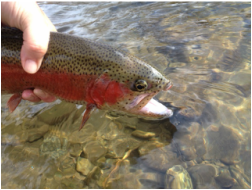 The WNC Fly Fishing Trail was created in the Winter of 2008-09. The first trail maps were printed and distributed in February of 2009. Since that time over 100,000 maps have been printed and give to anglers across the nation.If anyone would like a copy of the map, or trail information, you can contact AB's Fly Fishing Guide Service at alex@abfish.org or go directly to the trail website. You can also visit www.mountainlovers.com or call 800.962.1911 for a list of accommodations. The trail consists of 15 spots throughout Jackson County and the Cherokee Indian Reservation.This report, and those to follow, will combine some of the small streams, delayed harvest section of the Tuckasegee River, and the trophy section on Raven's Fork in Cherokee. Spring is just around the corner. The past month in Western North Carolina we have had temperatures ranging from below zero to the mid-sixties. That being said, I had a great morning on the Tuck a few days ago with several inches of snow on the ground. As always, the best time to go fishing is "when you can"!!!! Small Streams: As we move into hopefully warmer weather, we will still be seeing darker color flies hatching, usually around mid-morning or late afternoon. March Browns and Red Quills will be a couple of the bugs likely to hatch near the end of the months. Orange and Yellow stimulators are good dry fly choices in the swifter runs. Other good choices are Royal Coachman, Orange Palmer, Yellow Palmer, March Browns, and Red Quills. In deeper pools, you can add a dropper, such as a Copper John Bead Head, Brassie, Zebra Midge, or BH Pheasant Tail nymphs. Dry flys in sizes 12-18 and for the droppers, sizes 18-22. Fishing a nymph under an indicator is another option if the stream is large enough. Popular nymphs this month are: Stick Bait, Secret Weapon, Rubber Leg Prince Delayed Harvest Water: April begins the second month of NC Wildlife stocking of Delayed Harvest waters like the Tuckasegee in Jackson County. The stocking date listed on the NC WIldlife website is April 2, for the Tuck. The recently released trout usually take 24 to 48 hours to become acclimatized to their new environment.The delayed harvest section of the Tuckasegee River is on FIRE!!! Great time of the year to fish delayed harvest waters. Floating the Tuck is a good option when water levels are running high. Remember to always check the generation schedule at www.duke- energy.com and allow for approximately 5 hours from the time of the release until it arrives at the delayed harvest section in Webster. Fishing weighted nymphs under strike indicators is very productive. March Browns and Red Quills are starting to hatch mid-afternoon. Toward the end of the month, black caddis hatches should also take place after lunch. Some of the nymphs include: Rainbow Warriors, Rubber legged Copper Johns, BH Hare's Ear, San Juan or Squirmy worms. Weighted, larger stoneflys are producing very well lately. Big trout can be caught on streamers, but remember to slow your retrieve. Wooly Buggers in Olive, Black, and White are always good options. Varying the length and speed of your retrieve will be most productive. Listen to the fish, if they are taking the streamer more aggressively on shorter faster strips, thats the way you should fish them that day. Trophy Section: Ravens Fork, the trophy section in Cherokee, is still producing large Rainbow as well as some stream raised Browns. Fishing techniques and fly selection is very similar to that used in the delayed harvest section. Fish slowly and thoroughly in the more productive areas. The fish will hold in deeper water early in the day and move to shallower and swifter water as the sun gets higher in the sky. Small nymphs fished on light tippet and longer leaders under an indicator is a good option. As the weather warms look to fish closer to the banks, and especially undercut banks. Using larger, weighted stone flys will become even more productive as the month goes on. If you are comfortable with Czech Nymphing, it can be very productive. As always, please remember a Cherokee trophy section permit as well as a daily permit is required. productive fly patterns of late includes: egg patterns (orange & pink), purple San Juan worms, girdle bugs (black, olive, & brown #6 - #10) zebra midge black & red size 18 - 24 Wishing you Tight Lines & Bent Rods... 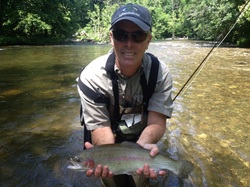 WNC Fly Fishing Trail News www.FlyFishingTrail.com Trail’s Delayed Harvest Waters to Receive Nearly 20,000 Trout SYLVA, N.C. – The delayed harvest section of the Tuckasegee River – a main stop on the Western North Carolina Fly Fishing Trail – will be stocked with 19,600 trout this fall. The stocking will be conducted by the North Carolina Wildlife Resources Commission in two segments: 9,800 trout the first week of October, and 9,800 trout the first week of November. Brook and rainbow trout will account for 80 percent of the fish placed in the river, with brown trout making up the remaining 20 percent. Anglers are allowed to fish the delayed harvest section of the Tuckasegee River year round. However, fish caught between Oct. 1 and the first Saturday in June must be released immediately. The delayed harvest section of the Tuck runs from the N.C. Hwy 107 bridge in the Lovesfield community to Dillsboro. “Your catch percentage goes up greatly when the delayed harvest waters of the Tuck are stocked in October and November,” said Alex Bell, a fly fishing guide in Sylva. “This provides a great chance to accomplish the ‘Tuckasegee Slam’ which is catching a brook, rainbow and brown all in the same day.” Another good place to fish the Trail this fall is Scott Creek. Scott Creek flows through Sylva and Dillsboro and received 3,000 brook, rainbow and brown trout in July and August. Both Scott Creek and the delayed harvest section of the Tuckasegee River were recently designated as Mountain Heritage Trout Waters by the N.C. Wildlife Resources Commission. The program encourages trout fishing as a heritage tourism activity and allows anglers to fish the waters by purchasing a three-day license for just $5. Those who already have a valid N.C. fishing license and trout privilege license do not need to purchase the three-day license. For info on the Fly Fishing Trail, call (800) 962-1911, or go to: www.FlyFishingTrail.com. # # # A few dates available for wade and/or float trips with Alex at AB's Fly Fishing Guide Service. Call for availability, 828.226.3833, or go to the website at www.abfish.org. In addition to the Tuck DH, guided trips are available on the other 14 spots on the WNC Fly Fishing Trail. Email Alex at [email protected] for more information. by Alex Bell Original story published at: http://www.wjhl.com/story/22243536/cable-country-goes-fishing-on-the-wnc-fly-fishing-trail
Cherokee, NC (WJHL) - Retired high school principal Alex Bell says he's changed careers, but he's still teaching and coaching, He's a guide along the scenic Western North Carolina Fly Fishing Trail. According to Bell, the Western North Carolina Fly Fishing Trial is the first and only designated fly fishing trail in the country. There are 15 designated hot spots around Jackson County and one at the 2.2 mile catch and release stream at Raven Fork on the Cherokee Indian reservation. According to Bell, the trail has just about everything a fly fisherman is looking for and that's bringing in tourist dollars. "It brings a lot of people in from a lot of places and even gets people interested in fly fishing that hasn't been before, " Doug Reed said. Alex Bell worked with Tim on his form. "Managing line is a big part of trout fishing and fly fishing. You're trying to work on your timing, tempo and technique. Harder is not farther in fly fishing and that's one of the most difficult things to get across to people they want to rear back and sling it instead of letting the rod and the line do what they're designed to do but it's such a relaxing atmosphere once you get involved with it it's very addictive," said Bell. For more information about the trail, click here. By Alex Bell 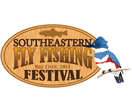 We'll be at the Southeastern Fly Fishing Festival from May 17-May 19th. The festival includes live music, an auction, educational sessions, exhibitors, and more. Please join us for the fun! Alex will be speaking four times during the festival on the following topics: Therapeutic Benefits of Fly Fishing/Tying and Instructing People with Disabilities
By Alex Bell |
|
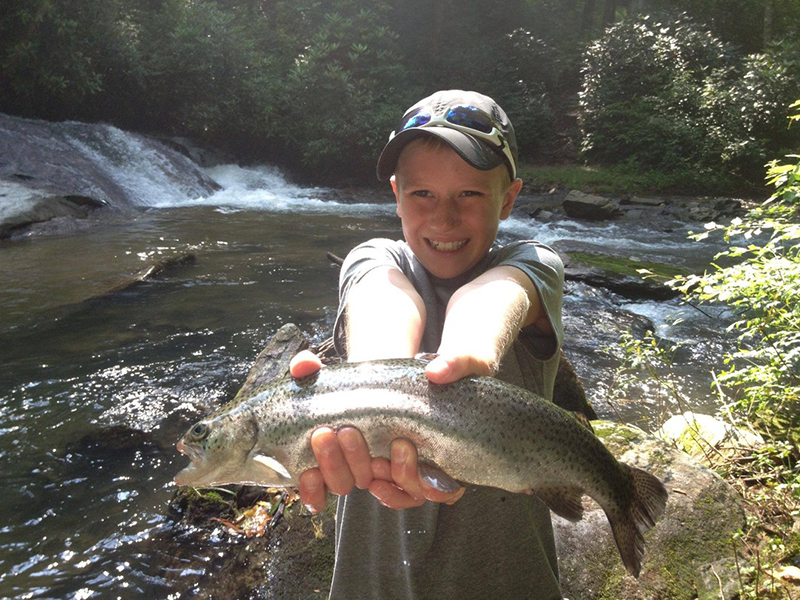
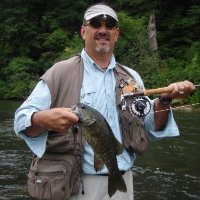

 RSS Feed
RSS Feed